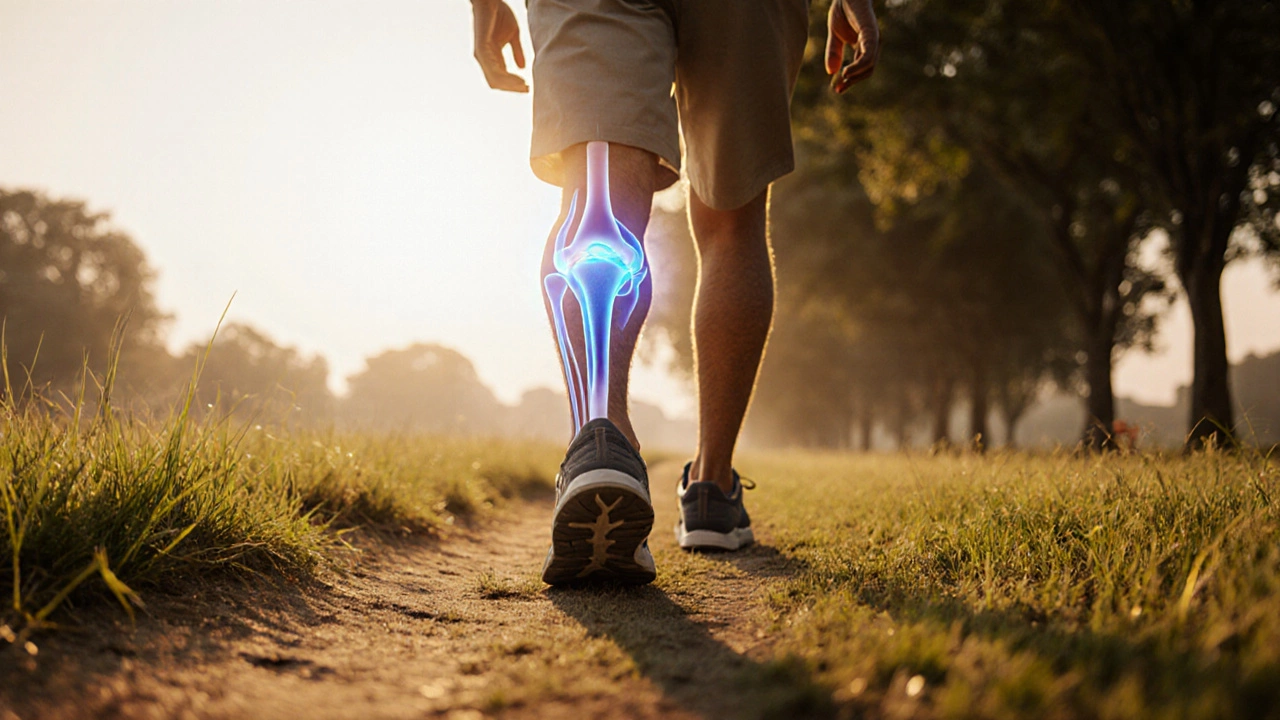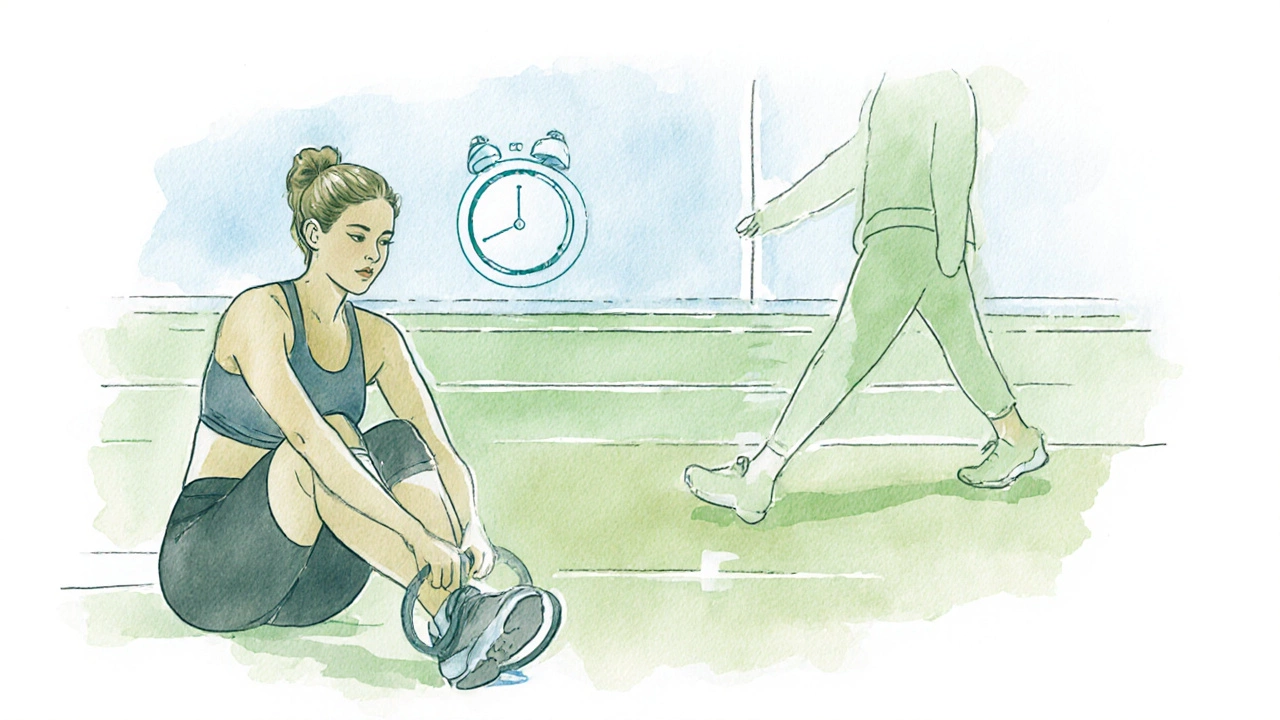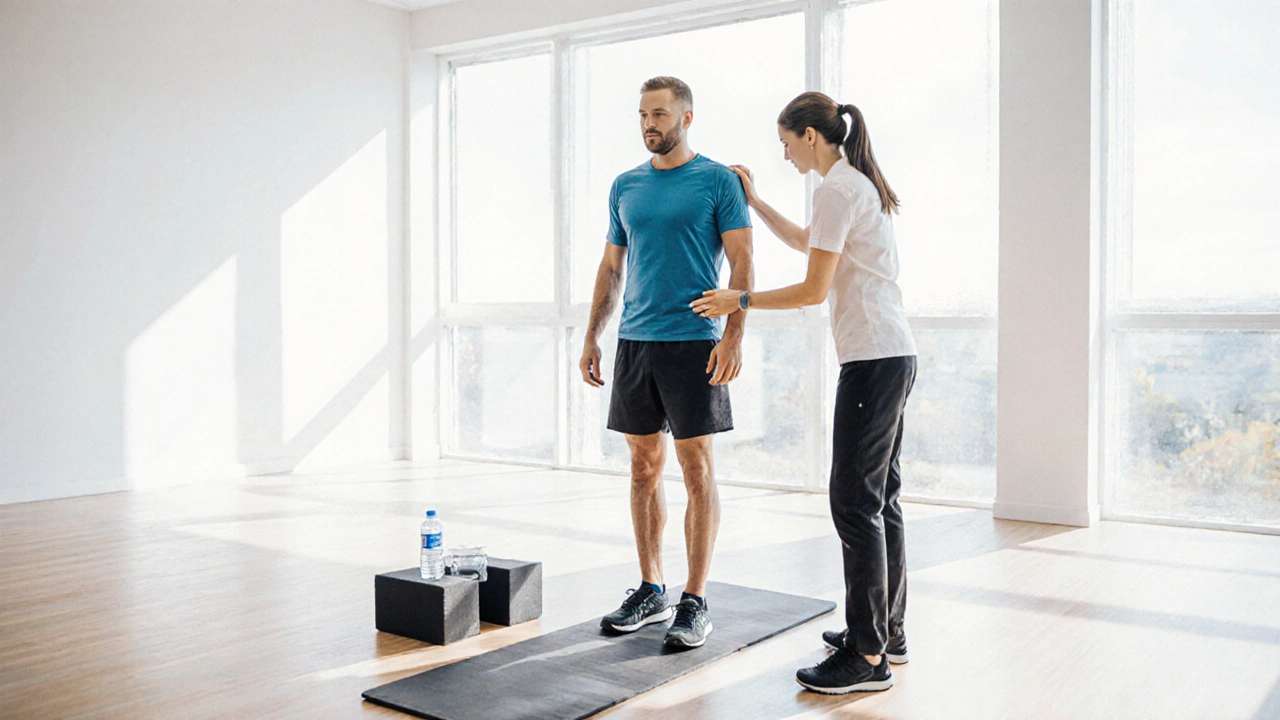
- Oct, 14 2025
- 0
Safe Walking Calculator for Stiff Knees
Personalized Walking Plan
Calculate your safe walking duration based on your current pain level and experience. Always listen to your body.
Your Input
Your Results
Enter your pain level and experience to see your personalized walking plan.
Key Takeaways
- Walking is a low‑impact, weight‑bearing activity that can improve circulation and strengthen muscles around the knee.
- When done correctly, walking may reduce stiffness and increase range of motion.
- Over‑doing it, walking on hard surfaces, or ignoring pain can aggravate knee problems.
- A gradual, timed plan combined with stretching and strengthening yields the best results.
- Seek professional advice if pain worsens or is accompanied by swelling, locking, or instability.
When it comes to joint health, Walking is a low‑impact, weight‑bearing activity that promotes circulation and muscle support around the knee and often gets recommended for people with stiff knees.
Understanding why a knee feels stiff helps you decide if walking is the right move. The knee joint connects the thigh bone (femur) to the shin bone (tibia) and includes cartilage, ligaments, tendons, and a fluid‑filled capsule relies on smooth interaction between these components. When any part loses its glide-because of aging, reduced synovial fluid, or cartilage wear-stiffness follows.
What Causes Knee Stiffness?
Several factors can make the knee feel tight:
- Cartilage the smooth tissue that cushions bone‑on‑bone contact thins out with osteoarthritis, reducing the joint’s natural glide.
- Synovial fluid the lubricating liquid inside the joint capsule can become less viscous after periods of inactivity, leading to a “creaky” feeling.
- Inflammation from micro‑injuries, over‑use, or underlying conditions (e.g., rheumatoid arthritis) causes swelling that restricts movement.
- Weak surrounding muscles, especially the quadriceps and hamstrings, fail to support the joint properly, making it feel stiff after sitting or sleeping.
How Walking Helps the Knee
Walking tackles many of the underlying problems:
- Boosts synovial fluid circulation: Each step gently compresses the joint, encouraging fluid to move and lubricate cartilage.
- Activates the quadriceps the front thigh muscle that stabilises the knee and hamstrings, improving joint alignment.
- Low‑impact nature means the forces transmitted to the knee are modest-roughly 1.2 times body weight compared with running’s 2.5‑3 times.
- Regular walking promotes mild aerobic conditioning, which can aid weight management and reduce extra load on the knee.
- Psychologically, a steady walk releases endorphins that lower perceived pain.

When Walking Might Make Stiff Knees Worse
Not every walk is a win. Watch out for these red flags:
- Hard surfaces (concrete, asphalt) increase impact forces; pavement‑friendly shoes or a track can mitigate the load.
- Sudden spikes in distance or speed-especially if you’re new to activity-can overload cartilage and trigger inflammation.
- Walking with an existing acute injury (e.g., meniscus tear) may exacerbate damage.
- Persistent sharp pain, swelling, or a feeling of the knee “locking” signals you should pause and see a clinician.
A Safe Walking Plan for Stiff Knees
Follow these steps to make walking a therapeutic habit rather than a source of irritation:
- Start with a warm‑up: 5minutes of gentle marching in place, ankle circles, and seated knee extensions.
- Choose the right surface: A rubberized track, grass, or a well‑maintained trail reduces impact.
- Set a realistic duration: Begin with 5‑10minutes at a comfortable pace (roughly 2-3km/h). Aim for a “talk‑test” speed where you can speak full sentences without gasping.
- Monitor pain level: Use a 0‑10 scale; stop if pain rises above 3 or if you notice swelling.
- Progress gradually: Add 2-3minutes each week, or increase distance by 10% maximum per week.
- Cool down: End with 5minutes of slower walking and static stretches for the calves, quads, and hamstrings.
- Footwear matters: Shoes with good arch support and cushioning (around 10‑12mm midsole) protect the knee.
Complementary Moves and Lifestyle Tips
Combine walking with a few simple exercises to keep the knee supple:
- Straight‑leg raises strengthen the quadriceps without bending the knee: 2sets of 10reps while seated.
- Heel slides gentle flexion exercises that improve range of motion: slide the heel toward the buttocks for 10seconds, repeat 8times.
- Consider a weekly physiotherapy session focused on knee mobility and strengthening to tailor a program to your condition.
- Maintain a healthy weight; each kilogram of extra weight adds roughly 4kg of load to the knee during walking.
Common Pitfalls to Avoid
- Skipping the warm‑up or cool‑down-muscles need time to adapt.
- Wearing worn‑out shoes; tread wear reduces cushioning and can shift alignment.
- Ignoring pain signals; mild soreness is okay, sharp or worsening pain is not.
- Walking on steep hills without building a base; it adds eccentric load that can strain the joint.
- Forgetting to hydrate; dehydration can thicken synovial fluid and make the joint feel tighter.

Comparison of Low‑Impact Activities for Stiff Knees
| Activity | Impact on Knee (1‑Low, 5‑High) | Calories Burned (per 30min, 70kg) | Ease of Access |
|---|---|---|---|
| Walking (flat surface) | 1.2 | 150 | Very high |
| Swimming | 0.5 | 200 | Medium (pool needed) |
| Cycling (stationary) | 0.8 | 180 | Medium (bike required) |
When to See a Professional
If any of the following occur, schedule an appointment with an orthopaedic specialist or physiotherapist:
- Swelling that doesn’t subside after rest and ice.
- Persistent pain above 4/10 for more than a week.
- Locking, catching, or feeling that the knee gives way.
- Recent trauma (fall, twist) with increasing stiffness.
Frequently Asked Questions
Can I walk every day if my knees are stiff?
Yes, daily short walks (5‑10minutes) are fine as long as you stay within a pain‑free range and use supportive shoes. Gradually increase time, but listen to your body.
Is walking better than swimming for knee stiffness?
Swimming offers the lowest impact, making it ideal if you have acute inflammation. Walking, however, adds weight‑bearing benefits that improve bone density and muscle strength. The best choice depends on your pain level and access to a pool.
How long should a walking session be to see benefits?
Most research shows 30minutes of moderate‑pace walking at least three times a week improves joint lubrication and reduces stiffness. Beginners can start with 10‑minute bouts and build up.
What shoes are best for walking with stiff knees?
Look for shoes with good arch support, a cushioned midsole (around 10‑12mm), and a firm heel counter. Replace them every 500-800km to keep cushioning effective.
Should I stretch before I start walking?
A brief dynamic warm‑up (marching, leg swings) is better than static stretching before walking. Save static stretches for the cool‑down to improve flexibility.
Next Steps
Start with a 5‑minute walk tomorrow morning on a soft track, record how your knee feels, and add a simple quad raise after the walk. Keep a log of pain scores and distance for two weeks. If the stiffness eases, continue to build up to 30minutes; if it worsens, reach out to a physiotherapist for a personalized plan.
Nikhil Verma
I'm a dedicated physician with a passion for exploring the intricacies of medicine, focusing on the unique healthcare challenges in India. I spend much of my spare time writing articles aimed at improving public understanding of health issues. Balancing my clinical practice and writing allows me to reach a wider audience, sharing insights and fostering a deeper appreciation for medical advancements. I derive immense satisfaction from both treating patients and engaging with readers through my writing.